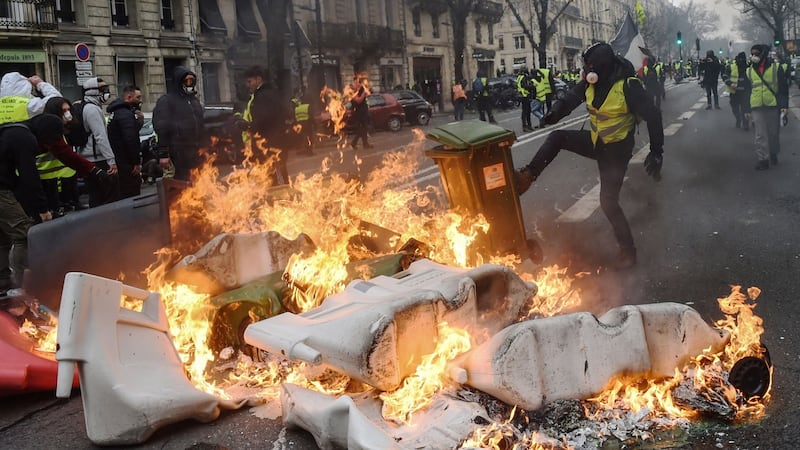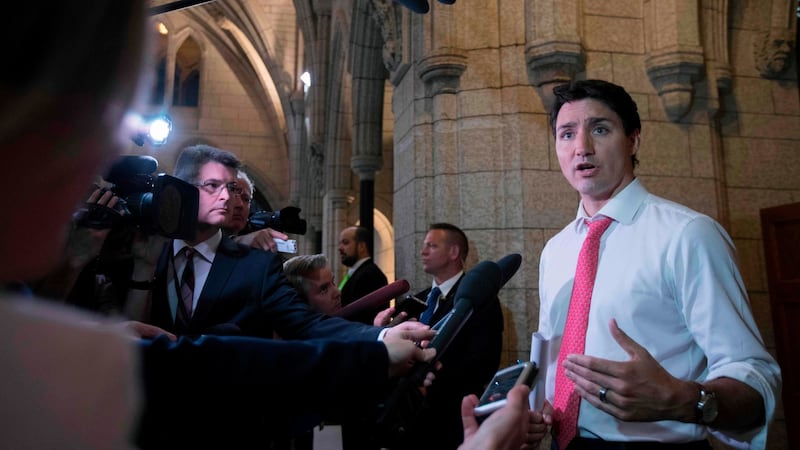Ever since the water charge protests, Irish governments have approached any new source of tax with extreme caution. Water charges themselves were binned.
We are assured the local property tax won't rise by much. And now we are told that future increases in carbon tax, a policy to reduce greenhouse gas emissions, may be returned to households via a cash payment, as the Government here reacts not only to domestic politics but also the big protests in France.
How could such a policy work? Are we heading for really sharp prices rises on fuels? And what is it likely to mean for your household finances?
Carbon tax – the theory.
We are used to thinking of taxes as ways of raising revenue for the State, with specific measures to encourage certain activities. But some taxes are designed principally to change behaviour – for example the new tax on sugary drinks. Of course they can also raise revenue for the exchequer and tax on tobacco, for example, has been a big contributor to our exchequer for many years.
Carbon tax is set to be increased as an attempt to change behaviour and make a contribution to meeting our national environmental targets – an area where we are struggling nationally and at risk of facing significant fines.
It is an attempt to put a price on carbon to reflect, to some degree, the costs to society of climate change from those emissions. In turn this is intended to change our behaviour, leading us to move towards less polluting cars, to save energy in our homes, use less-polluting fuels and so on.
While like any tax it raises money for the exchequer, the Government has indicated that it intends to refund most or all of this through other channels .
Carbon tax is also designed to change the behaviour of businesses, pushing them to use less polluting fuels and increasing the incentive to invest in what should be increasingly popular – and thus profitable – technologies.
The move to increase the tax over a period of years now looks inevitable. We are way behind on our targets. Under our climate targets, emissions here are due to be 20 per cent below 2005 levels by 2020 and 30 per cent lower by 2030, but Ireland looks set to miss the 2020 target significantly.
According to the body advising the government on the issue , the Climate Advisory Council, emissions of CO2 are increasing by 2 million tonnes a year, when an annual reduction of 1 million tonnes is what is needed.

Carbon tax in Ireland is currently levied at €20 per tonne on the burning on fossil fuels such as oil, diesel, petrol, coal, gas and peat. The Climate Advisory Council called on it to increase this to €30 per tonne in the last budget, rising to €80 by 2030, around the level which international bodies suggest is appropriate.
But how high will it go? And what other policies do we need to turn around out carbon story.
These are likely to include special measures aimed at agriculture, possibly alterations in the emissions trading regime which applies to big business and a commitment by Ireland to move away from more polluting ways of generating electricity. But the carbon tax is seen as a fundamental tool in the national effort.
Carbon tax – the costs
The cost to us of the €20 per tonne existing level of carbon tax depends on our habits. But it is not a big issue for most household budgets. For example it costs us 5.3 cent on every litre of diesel we put in our cars, 52 cent on a bale of briquettes and €2.10 on a small bag of coal. The tax yields over €400 million to the exchequer – or around €100 per head of population – is slightly less than the local property tax.
How far will the tax rise? Quite a lot, if it is to have any impact on our carbon emissions.
The Government had been expected to increase the tax to €30 per tonne in last October’s budget which would have led to a modest rise in prices – another €1.20 on a bag of coal, for example of a couple of cent extra on a litre diesel.
It could have done this with little political kick-back. But the bigger question is outlining a plan for further successive increases in the years ahead. That was a political risk the Government was not willing to take, at least not without trying to get some political consensus and working out how it would return a lot of the cash raised to households.
How far will the tax rise? Quite a lot, if it is to have any impact on our carbon emissions. The council recommended aiming for a level of €80 a tonne by 2030 and the Minister in charge of climate policy, Richard Bruton, has suggested policy met be set around a figure of €100 a tonne, again by 2030.
However Ireland has a big problem and work by the ESRI has suggested that the tax might have to go as high as €300 per tonne in the years ahead if we are to meet our targets, or perhaps even higher if other accompanying policies were not introduced.
One reason the number is so high, according to Dr Kelly de Bruin of the ESRI, is that around half of Irish greenhouse gas emissions are coming from areas not covering by the EU emissions trading system (ETS) – the scheme covering energy generators and big businesses who trade carbon allowances.
This is around twice the international average, in part due to our reliance on agriculture. So as things stand Ireland will have to rely significantly on the carbon tax to reduce emissions.
The problem now is that incremental increases will still leave the tax at a relatively low level and have a limited impact on behaviour. For example the ESRI points out that even a doubling of the tax would only add 7 per cent to the cost of diesel, within the range of variations which motorists are used to facing. It would be likely to lead to a modest 5 per cent cut in emissions, they calculate.
But while the initial hit on household budgets would be small, the successive rises would be significant – and this is why outlining a long-term plan is important. A rise to €100 per tonne, for example, would cost households around €500 per year on today’s figures and lead to a significant rise in the cost of more polluting fuels such as coal.
As we have seen in France, these issues can be politically sensitive, with the government there forced to back down on a planned tax hike this year.
Carbon tax – the give back
The Government has made clear that it is looking at ways to return cash raised via the carbon tax to households. The theory is that most would not lose out in net terms, but that the incentive would be there to gain more by cutting the consumption of damaging fuels.
A range of studies have pointed out that measures will be needed in particular to protect poorer households, who would be vulnerable, via the welfare system. However it seems that Ireland may go further and comments by Taoiseach Leo Varadkar suggest he is looking at the approach being taken in Canada.

There, Justin Trudeau’s federal government is pushing provinces without an existing carbon tax to introduce one, but promising that 90 per cent of the tax collected will be returned to households via refunds or tax cuts. The rest will go to small and medium-sized businesses, schools, hospitals and other organisations that can’t pass on their costs from the carbon tax directly to consumers.The goal is thus purely to change behaviour, not raise revenue, with a promise that seven out of ten households will end up better off.
Here, the Taoiseach has said one option is just returning cash to households in a similar fashion – effectively via an annual cheque – albeit a mechanism for doing so would have to be worked out. A variant of this would be to link it to explicit changes in general income tax and social welfare payments in a way which would have a similar result, even if doing so is trickier in terms of ensuring a similar return to all households.
A third option would be to compensate poorer households via higher welfare and focus the rest of the revenues more directly at specific problems – the relatively high tax rate on middle incomes, for example, or the issue of child poverty, or whatever was chosen.
As we saw from the water charge issue – and from what has happened in France – the political price for getting this wrong is high.
Cash could also go towards environmental investments – and at a local level be directed at less well-off households to help them move to cleaner fuels, insulate their homes and so on.
Economists would argue that this more focused approach could probably achieve better result. As Dr de Bruin points out, this could help to boost the economy’s growth potential and address particular problems. However the politics may demand a scheme which demonstrably returns cash to households, does not leave many worse off , while still offering a clear incentive to change behaviour.
A particular challenge is protecting low-income households. ESRI research shows that while richer households are bigger carbon polluters and would pay more in cash terms, the proportionate hit on less well-off households would be higher, as they spend more of their incomes in the areas affected by carbon tax.
Rich households will pay 4.5 per cent more in energy bills from a €20 per tonne increase in the tax, while poorer ones would face a 2.9 per cent rise.However, the poorer households still lose a higher proportion of their income.
The bottom line
The bottom line is that big increases in carbon tax now look inevitable, given the climate change agenda and the very significant fines Ireland will start to face from not meeting its targets, likely to run into the hundreds of millions from 2020.
A key task for the Government is to set out clearly a long-term plan of action. This seems the best way of changing behaviour, as people start to factor in the impact of a succession of small annual changes. Working out the payback mechanism will also be vital politically.
Arguably the most efficient approach might be to focus on refunding poorer households and direct the rest of the cash to address specific issues. However the politics may dictate otherwise and we could head towards a Canadian style approach.
As we saw from the water charge issue – and from what has happened in France – the political price for getting this wrong is high.
Smart Money is a weekly subscriber-only column looking at the big economic trends and how they affect you















